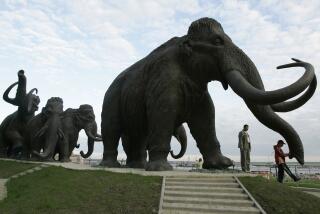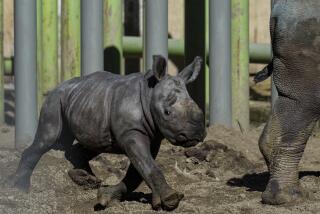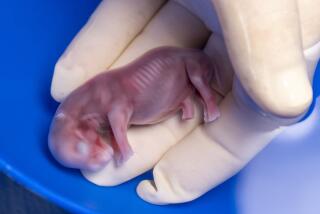The last male northern white rhino has died, spelling probable extinction for the species
- Share via
Reporting from Johannesburg, South Africa — Sudan, the last male northern white rhinoceros, died in Kenya, officials announced Tuesday, spelling almost certain extinction for one of Africa’s iconic species.
Sudan’s death leaves only two female rhinos of the species, Fatu and Najin, neither capable of natural reproduction, at the Ol Pejeta Conservancy in Kenya, where Sudan lived out his final years.
The three rhinos were sent to Kenya in 2009 from Dvůr Králové Zoo in the Czech Republic in the hope they would reproduce.
Hopes rose in 2012 when two of the rhinos at Ol Pejeta mated, but the cow did not become pregnant. Breeding efforts since have failed, with neither of the surviving females capable of natural reproduction.
The best chance for bringing the species back from the edge of extinction is in-vitro fertilization using eggs from the surviving females, stored semen from dead males and a surrogate female rhino from another subspecies such as the southern white rhino, according to Ol Pejeta Conservancy.
Rhinos have been in danger for decades because of poaching by criminal syndicates for rhino horn, sold illegally mainly in China and Vietnam.
The range of the northern white rhino was in central Africa, including Democratic Republic of Congo and the Central African Republic, where myriad militias often rely on income from illegal trafficking of minerals, wildlife products and timber.
The western black rhino, last seen in northern Cameroon, was declared extinct in 2011 after a survey of rhino populations in Africa. The International Union for the Conservation of Nature warned in 2006 that the world was on the brink of losing the northern white rhino, with only four surviving in Garamba National Park. By 2008, the species was considered extinct in the wild.
Sudan was 45 years old and could no longer stand up. He had been treated for age-related degeneration of muscles and bones, as well as extensive skin wounds, according to a joint statement from Ol Pejeta Conservancy and Dvůr Králové Zoo.
The decision to euthanize Sudan was made Tuesday by a veterinary team from the zoo, the conservancy and Kenya Wildlife Service.
“During his final years, Sudan came back to Africa and stole the heart of many with his dignity and strength,” the statement said. “His condition worsened significantly in the last 24 hours; he was unable to stand up and was suffering a great deal.”
Ol Pejeta Chief Executive Richard Vigne hoped Sudan’s death would focus global attention on the need to preserve species from extinction.
“We on Ol Pejeta are all saddened by Sudan’s death. He was a great ambassador for his species and will be remembered for the work he did to raise awareness globally of the plight facing not only rhinos, but also the many thousands of other species facing extinction as a result of unsustainable human activity.
“One day, his demise will hopefully be seen as a seminal moment for conservationists worldwide,” Vigne said.
The last wild northern white rhinos lived in Garamba National Park in northeastern DRC, but fighting and poaching in the 1990s and 2000s wiped out all but a few. In 2005 the DRC government agreed to move five surviving rhinos from Garamba National Park to Kenya for safety, but the plan was never carried out.
The park has faced encroachment by highly organized criminal syndicates for decades, many operating from the countryof Sudan, a major trafficking hub for wildlife. Elephants in the park are currently under severe risk from poachers.
The male rhino Sudan was moved from Africa to the Dvůr Králové Zoo in the 1970s when rampant poaching threatened to wipe out the species. Sudan sired two females, offering hope that the species could be preserved.
The two surviving females were born in captivity. They were transferred from the Czech Republic to Ol Pejeta Conservancy in 2009 with Sudan and another male, Suni. Suni died of natural causes in 2014.
Sudan’s DNA, along with that of other northern white rhinos, has been preserved in the hope that it can be used in the future to revive the species.
Rhino horn has been prized in China for traditional medicine and more recently as a status item used in bracelets and jewelry. One of the main trafficking hubs in Asia is Vietnam, with rhino horn, ivory and other illicit items crossing its border into China.
In recent years, poaching of rhinos has been concentrated in southern Africa, particularly in South Africa, where 85% the world’s 25,000 rhinos survive. Most poaching cases occur in Kruger National Park, which shares a border with Mozambique, where many of the trafficking gangs are based.
South Africa, hamstrung by corruption and security lapses, loses nearly three rhinos a day to poaching. Last year in South Africa, 1,028 rhinos were poached, a slight drop from 2016, when 1,054 were killed. At least 21 South African security or environmental officials, including police, soldiers and rangers, were arrested last year, suspected of poaching.
Private owners are important to the species’ survival, maintaining more than 6,500 rhinos on an estimated 330 private game reserves, spanning 5 million acres. But armed security guards and technology are required to keep the animals safe, and the cost of security measures to protect rhino herds has made it difficult for smaller game farmers to keep rhinos.
The Institute for Conservation Research at San Diego Zoo has mounted a project to try to bring the northern white rhino back from the brink of extinction. Researchers at the zoo aim to use genome sequencing and stem cell technology to create northern white rhino embryos. From there embryo transfer could be employed, using southern white rhinos as surrogate mothers.
“One day we hope to see this species saved through successful births of northern white rhino calves at the Nikita Kahn Rhino Rescue Center,” the zoo’s website says.
Twitter: @RobynDixon_LAT
UPDATES:
9:40 a.m.: This article was updated throughout with additional information, including background on a project at the San Diego Zoo.
7:35 a.m.: This article was updated throughout with staff reporting and additional details.
This article was originally published at 12:05 a.m.
More to Read
Sign up for Essential California
The most important California stories and recommendations in your inbox every morning.
You may occasionally receive promotional content from the Los Angeles Times.










